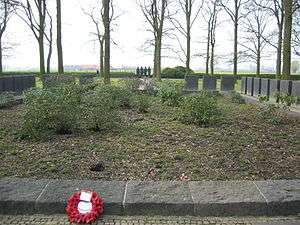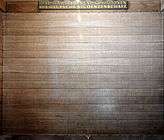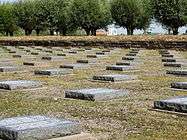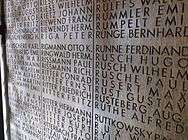Langemark German war cemetery
| Langemark German war cemetery | |
|---|---|
|
German War Graves Commission Volksbund Deutsche Kriegsgräberfürsorge. | |
 This mass grave contains 24,917 soldiers of whom 7,977 remain unknown. The names of those known are on the surrounding basalt blocks. | |
| Used for those deceased 1915-1918 | |
| Established | 1915 |
| Location |
50°55′14″N 2°55′0″E / 50.92056°N 2.91667°ECoordinates: 50°55′14″N 2°55′0″E / 50.92056°N 2.91667°E near Langemark-Poelkapelle |
| Total burials | 10,143 + ca. 9,470 (graves); 24,917 (mass grave) |
| Unknown burials | 3,836 (graves); 7,977 (mass grave) |
| Burials by nation | |
|
Great Britain | |
| Burials by war | |
The German war cemetery of Langemark (formerly spelt 'Langemarck') is near the village of Langemark, part of the municipality of Langemark-Poelkapelle, in the Belgian province of West Flanders.[1] More than 44,000 soldiers are buried here.[2] The village was the scene of the first gas attacks by the German army in the western front (see trench map), marking the beginning of the Second Battle of Ypres in April 1915.
During the First Battle of Ypres (1914) in World War I, inexperienced German infantry suffered severe casualties when they made a futile frontal attack on allied positions near Langemark and were checked by experienced French infantry and British riflemen. Contrary to popular myth, only fifteen percent of the German soldiers involved in the Battle of Langemark were schoolboys and students. Legend has it that the German infantry sang the first stanza of what later (1919) became their national anthem "Deutschland, Deutschland über alles", as they charged.
The cemetery, which evolved from a small group of graves from 1915, has seen numerous changes and extensions. It was dedicated in 1932. Today, visitors find a mass grave near the entrance. This comrades' grave contains 24,917 servicemen, including the Ace Werner Voss.[3] Between the oak trees, next to this mass grave, are another 10,143 soldiers (including 2 British soldiers killed in 1918). The 3,000 school students who were killed during the First Battle of Ypres are buried in a third part of the cemetery. At the front of the cemetery is a sculpture of four mourning figures by Professor Emil Krieger. The group was added in 1956, and is said to stand guard over the fallen. The cemetery is maintained by the German War Graves Commission, the Volksbund Deutsche Kriegsgräberfürsorge.
Otherwise, this cemetery has two Commonwealth burials. [4]
Adolf Hitler visited the cemetery on 1 June 1940 during a two-day tour of the Ypres front where he had served in World War I.[5]
Gallery
 This wreath marks the largest mass grave.
This wreath marks the largest mass grave. Individual marker of four unknown soldiers.
Individual marker of four unknown soldiers. This map is a key to World War I German soldier burial sites in Belgium, located in the entrance block.
This map is a key to World War I German soldier burial sites in Belgium, located in the entrance block. One wall listing the names of the 3,000 German students killed during the First Battle of Ypres, inside the entrance block.
One wall listing the names of the 3,000 German students killed during the First Battle of Ypres, inside the entrance block. Flat grave markers.
Flat grave markers. For the 100th anniversary commemoration of World War I, many cemeteries and other sites have had ceramic poppies installed.
For the 100th anniversary commemoration of World War I, many cemeteries and other sites have had ceramic poppies installed. A section of the memorial wall to the victims of the massacre of the Innocents.
A section of the memorial wall to the victims of the massacre of the Innocents.
References
| Wikimedia Commons has media related to Deutscher Soldatenfriedhof Langemark. |
- ↑ "Germany lays nightmares to rest - BBC". BBC News. 1998-11-11. Retrieved 2014-04-11.
- ↑ Langemark - Volksbund Deutsche Kriegsgräberfürsorge
- ↑ "The Great War 1914-18: Ypres Salient war graves". Greatwar.co.uk. 1932-07-10. Archived from the original on 2013-11-10. Retrieved 2014-04-11.
- ↑ CWGC: Langemark German Military Cemetery
- ↑ "June 1, 1940". The Hitler Pages. Retrieved 4 September 2018.